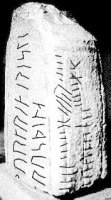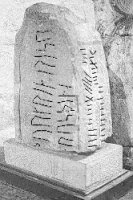This is the only "bilingual" inscription in Runic Norse and Ogham Middle Irish known so far.
Size according to Macalister, CIIC: 2'11" x 1'6" x 8"
Runic inscription:
Reading Macalister, PRIA 38, 1929, 236:
ČURWUAP
Reading Macalister, CIIC:
[TH]URGRIM RISTI [KR]US THINA
"Thorgrim carved this cross".
Reading Gippert (1978 / 1981):
 Surface:
Surface:
[Č]URKRIM RISTI | [K]RUS ČINA
Ogham inscription:
Reading Macalister, PRIA 38, 1929, 236:
TOROQA ... NOMQA / AQMON / QOMNA / ANMOQ ?
Reading Macalister, CIIC:
BENDACHT [AR] TOROQR[IM]
Reading Gippert (1978 / 1981):
Surface,  central stem line, "down" || lower stem line, "down" (?):
central stem line, "down" || lower stem line, "down" (?):
BEýANDACHT [ ] || (T)[O](R)[OQ](R)[
çőęéěâîěëí[ ] || (é)[ă](ňń)[ăęé](ňń)[
çőçççççëëâëëëëćëćëëë[ ] || (ççç[ââ](ďď)ďďď[ââççççç]ďďďď[ď
Reconstruction:
*BEýANDACHT [AR] | TOROQR[IM
*çőęéěâîěëí[âňń] | íăňńăîíňń[ĺäď]
*çőçççççëëâëëëëćëćëëë[ćâďďďďď] | ëëëââďďďďďââëëëëëďďďďď[âââââď]
 frame engraved in the surface for this purpose, he must have inverted the two H-letters, T and Q as the
frame engraved in the surface for this purpose, he must have inverted the two H-letters, T and Q as the  photograph shows. Macalister's drawing in the CIIC is misleading in this point. Reading in the other direction, we would arrive at (R)QOROT. The central O is written with bent strokes, thus strongly reminding of the forfid ő; we would have to read EýA in this case.
photograph shows. Macalister's drawing in the CIIC is misleading in this point. Reading in the other direction, we would arrive at (R)QOROT. The central O is written with bent strokes, thus strongly reminding of the forfid ő; we would have to read EýA in this case.
- Macalister, PRIA 33, 1917, 493.
Additional literature:
Last changes of this record: 26.04.97
Copyright Jost Gippert, Frankfurt a/M 1996. No parts of this document may be republished in any form without prior permission by the copyright holder.




